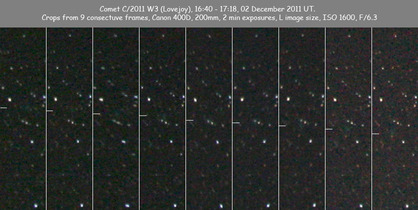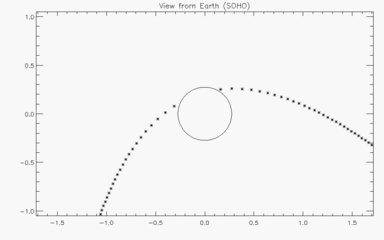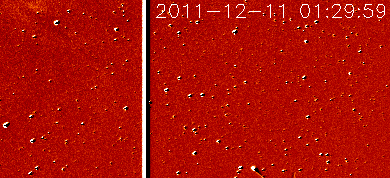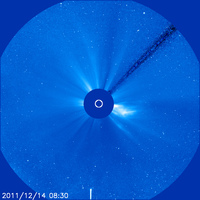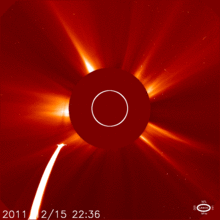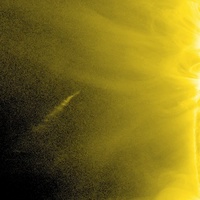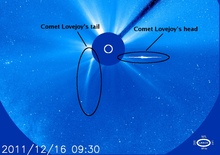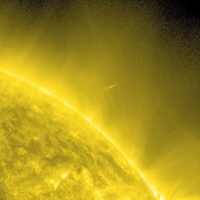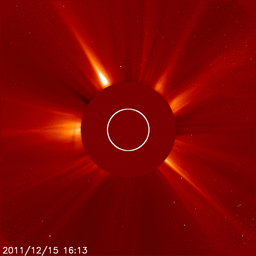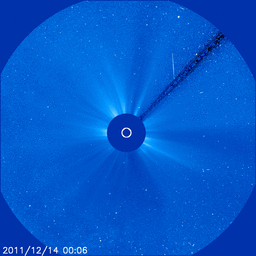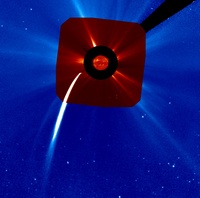Comet Lovejoy Grazes the Sun (and survives)
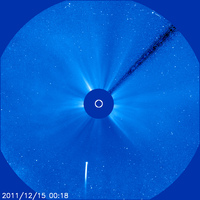 |
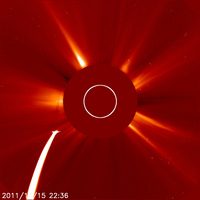 |
Comet Lovejoy entering LASCO C3's view on Dec. 14 (left) and continuing on
its path towards the Sun the next day as seen from LASCO C2.
Click on the images for a larger view.
Comet C/2011 W3 (Lovejoy), announced on SOHO's 16th launch anniversary (2 December 2011), took all experts by surprise: it survived its close encounter with the Sun and emerged intact after plunging through the several million degree solar corona.
It was discovered by Australian amateur astronomer Terry Lovejoy, who, as an early pioneer of discovering SOHO comets over the Internet, can now claim to be the first person to discover a sungrazing comet from both ground and space-based telescopes. As other ground-discovered Kreutz-group comets, Comet Lovejoy was predicted to get bright, and it did not disappoint. It turned into a truly spectacular object and attracted enormous interest by the public.
On December 15 and 16 (the day before and after perihelion passage), the SOHO web server alone set two single-day records for page views (2,878,750 and 3,037,971) and data downloaded (1.95 and 1.97 TB, respectively). Two instruments on SOHO (LASCO and UVCS) took special observations of this event. The measurements should provide outgassing rates and the size of the nucleus.
There are many questions scientists are puzzled with: What caused Lovejoy to lose its tail inside the Sun's atmosphere - and then regain it later? And how did Comet Lovejoy survive at all?
LINKS
Sungrazer Project Homepage and the detailed coverage of Comet Lovejoy by Karl Battams.
Haitian Creole translation of this page by Susan Basen (Web Geek Science).
TIMELINE
This is timeline of the events. Comet Lovejoy came into LASCO's view on Dec. 14 as a bright, white streak, skimmed across the Sun's edge about 140,000 km above the surface late Dec. 15 and early Dec. 16, 2011, furiously brightening and vaporizing as it approached the Sun. It exited our field of view on Dec. 18. It was the brightest sun-grazing comet that SOHO had ever seen. It unexpectedly survived the pass and cruised out from behind the Sun some hours later. Comets are ancient balls of dust and ice.
DECEMBER 2, 2011
|
On December 2nd, 2011 (SOHO's 16th launch anniversary), newly discovered Kreutz-group comet C/2011 W3 (Lovejoy) was announced. SOHO discovers these objects on average every three days, but this one is different... it was found from a ground based telescope, and marks the first such discovery in over 40 years. It also marks a significant achievement for Australian amateur astronomer Terry Lovejoy, who as an early pioneer of discovering SOHO comets over the internet, can now claim to be the first person to discover a Sungrazer from both ground and space-based telescopes! |
DECEMBER 3, 2011
|
|
Plot shows the expected trajectory of the comet close to the Sun. It passes behind the Sun as seen from Earth. |
DECEMBER 12, 2011
|
First full-resolution (cropped and scaled x2) sequence of Comet Lovejoy. Images from STEREO/SECCHI HI-1B. |
DECEMBER 14, 2011
| Comet Lovejoy (C/2011 W3) makes its debut in the LASCO C3 camera (click on the image for higher resolution). |
DECEMBER 15, 2011
|
Comet Lovejoy (C/2011 W3) continues cruising twoards the Sun as seen in the LASCO C2 camera (click on the image for higher resolution). It developed into the brightest sungrazing comet that SOHO has ever seen. Also, notice the faint ion tail: that's the first time we've seen this on a Kreutz-comet in LASCO! |
|
See the movie (QT, 8.9M) |
SDO's view of Comet Lovejoy (C/2011 W3) plunging through the million degree hot solar atmosphere. |
DECEMBER 16, 2011
|
Comet Lovejoy survives!!! Somehow it survived being immersed in the several million-degree solar corona for almost an hour and has now re-emerged back into the views of the LASCO and SECCHI coronagraphs, almost as bright as before! The only noteable exception is that it appears to have lost its tail, as you can see in the image. In later C3 images, we see a prominent dust ion tail again. What caused Lovejoy to lose its tail inside the hot solar atmosphere and then regain it later is a big puzzle. |
|
See the movie (QT, 5.8M) |
SDO's view of Comet Lovejoy (C/2011 W3) emerging form the other side of the Sun. |
|
Click on the image to see a LASCO C2 movie of Comet Lovejoy (C/2011 W3) approaching the Sun and then re-emerging from behind the Sun. |
|
Click on the image to see a LASCO C3 movie of Comet Lovejoy (C/2011 W3) approaching the Sun and then re-emerging from behind the Sun. |
|
Images: TIFF
(3.0M), PNG
(514K) |
Composite of comet Lovejoy in C3 and AIA 304 from 9:30 Dec 14 to 9:30 Dec. 15. |

